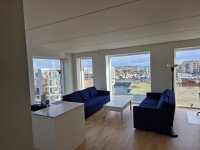I don't have usable AC anyway. Were I by myself, my wintertime thermostat would probably be set as low as possible, but that doesn't work for my roommates. I am RIGHT on the tip of Lake Michigan, and when the lake is cold, everything here is cold.
My file server takes 5 - 10 minutes to become fully usable if it gets shut down and it's mildly terrifying every time that happens because it probably means my UPS ran out of juice and I'm worried about whether or not all the drives are working OK or if an array needs rebuilt.
Moving that part of the discussion here as it'd gone a bit off the rails.
Meanwhile, I have practically no insulation, so most of my energy is spent just keeping my place barely hospitable. I'm hot in the summer, cold on the actually cold days of winter. The only saving grace is that it usually stays in the 70s through winter here so it's a somewhat rare occurance that the heat comes on especially since I believe it's monitoring my office for the thermostat anyway, and that room always trends a few degrees warmer due to my network equipment and server.
Speaking of the server, I shuffled around my storage devices and ended up putting the MP510 in my work laptop since I needed the storage there more, I spent last night cloning the drive over the network with Macrium -- we use it for work anyway, so it was conveniently already installed -- the retention mechanism for m.2 drives is rather bizarre in that machine but I got it working in the end. Unfortunately the stock drive was a 2230 PM991a, so it's going to be annoying to use in a desktop where the smallest m.2 most boards will let you mount is a 2242. I have an adapter bracket on the way to let me use it with the board I've got coming, meanwhile the EX920 I was using in my main will become the boot drive for the server, holding the images I'll be using to boot the VMs. I think I'm going to use Proxmox there -- I'd use ESXi since I'm more familiar with that, unfortunately the NIC on that board (a RTL8169) isn't supported by anything past 6.7, which EOLed back in, what, September I think. I've figured out how to control the bottom PCIe slot on that board independently of the rest and force it to PCIe 1.0 mode for the capture card, so I'll pass that through to the fileserver VM for convenience and just use it with OBS on there through SSH X-forwarding I guess.
I'm torn as to whether I want to upgrade the drives now -- I really would like a 3x8TB RAID5 of good WD Red Pros or IronWolves. I just need them to be CMR and have ERC, which I'm given to understand at more than 4TB is kind of difficult to come by (CMR that is). On the other hand, I really am not in the best spot to spend upwards of $400 on hard drives right now, and the 3x2TB array has surprisingly held up rather well since my early difficulties with it. I've got about 30% free on that array and the persistent growth has more-or-less stopped.
I moved my home LAN's subnet to 10.254.0.0/24 after getting frustrated with how my original setup at 192.168.0.0/24 was getting usurped by the local network when I'd connect my laptop through to the VPN on some networks. I'm aware you're supposed to be able to do some sort of subnet translation, but the documentation for OpenVPN flat-out suggested moving the subnet to a less-common one, so there we go. My VPN subnet was at 192.168.8.0/24 but I moved
that to 10.127.0.0/24. Surprisingly, making those changes went without a hitch -- I started by changing the address in /etc/network/interfaces on the server, knowing I'd break the SSH session when I called for the networking service to restart,
then I set the range up in the configuration on my router, then quickly changed the static IP I'd set on my main, and all's well now. I say surprisingly because I'm quite used to having to fight with equipment for hours to make simple changes like that, but my own LAN was quite well-behaved. I restarted most of my devices to make sure they all got new IPs with DHCP, and so far, I haven't had any issues.

